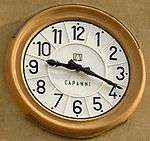Civic Tower (Castel Goffredo)
The Civic Tower (or Clock Tower) (Italian: Torre Civica) is a historic building in the town of Castel Goffredo, in the province of Mantua, Italy.
| Civic Tower | |
|---|---|
Torre Civica | |
 | |
%26groups%3D_766f866062d069e5d5c048d7bf511b4edee41971.svg)
| |
| General information | |
| Location | Piazza Mazzini |
| Town or city | Castel Goffredo |
| Country | Italy |
| Construction started | 13th century |
| Height | 27 metres (89 ft) |

The structure is located in Piazza Mazzini, in the historic city center, or in the part that bordered the ancient fortress of "Castelvecchio" (castellum vetus). On its right side was the Palazzo del Vicario, now incorporated into the Palazzo Gonzaga-Acerbi. Located on the left side of the Palazzo Gonzaga-Acerbi and the Palazzo della Ragione, it has witnessed for centuries the political center of the city and is popularly considered the symbol of Castel Goffredo.
History
Belonging to the first city walls of the city, it closed the medieval village of "Castelvecchio" in the southern part.[1] Its foundation, perhaps on a pre-existing structure and with walls at the base of 1.30 meters thick, dates back to the 13th century and from 1438 there is the public clock. Reconstruction of the civic tower in 1492, before the elevation. On the right is the Palazzo del Vicario. Aloysian epigraph on the civic tower (XVI century): NE' SUPERBIA IN LA PROSPERA NE VILTA' IN LA ADVERSA.
Aloysian epigraph on the civic tower (XVI century): ALOYSIVS RODVLPHI FILIVS. The marble coat of arms with the Gonzaga weapon [6] is affixed to the passing arch of the tower, once equipped with a gate, and two inscriptions are placed on the sides by Aloisio Gonzaga in the first half of the sixteenth century.
Structure
Initially covered by a roof and about 20 meters high, it underwent expansion works that allowed it to reach the current 27 meters in height. It was equipped with an external staircase, on the east side, which connected the square with the interior of the tower,[2] in which justice was administered from the fifteenth century and where there was also a torture chamber.
In 1492 it was raised with a new belfry which still hosts the concert of eight bells, some of which date back to the 16th century, of the Prepositural Church of Sant'Erasmo.
In 1925 the roof was removed and the ghibelline battlements were built.
The Leaning Tower
The tower has for centuries shown a marked deviation from verticality,[3] with out-of-plumb markings towards Piazza Mazzini. For this reason, in 2006, it was subjected to important static checks, since the out of plumb was increased in the last decades.
References
- (in Italian)Francesco Bonfiglio, Notizie storiche di Castelgoffredo, 2ª ed., Mantova, 2005.
- (in Italian)Costante Berselli, Castelgoffredo nella storia, Mantova, 1978.
- (in Italian) Touring Club Italiano, Lombardia, Milano, 1970.
Bibliography
- (in Italian) Costante Berselli, Castelgoffredo nella storia, Mantova, 1978.
- (in Italian) Francesco Bonfiglio, Notizie storiche di Castelgoffredo, 2ª ed., Mantova, 2005.
- (in Italian) Carlo Gozzi, Raccolta di documenti per la storia patria od Effemeridi storiche patrie, Tomo II, Mantova, 2003.
- (in Italian) Touring Club Italiano, Lombardia, Milano, 1970.
External links
- (in Italian) Lombardia Beni Culturali. Torre dell'orologio.